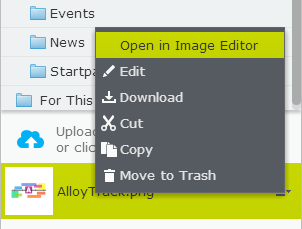 Media
Media
Media in Episerver are an image, a document (such as a pdf document or a Word document), a video or mp3 files. Media is managed from the media library on the Media tab in the assets pane where you can create folders and upload media files. You can then make use of your media by dragging them into an Episerver CMS page or a block, or associating them with a product in Episerver Commerce.
Searching for media
Use the search field at the top of the pane to enter search criteria and retrieve media files. Clicking a search result expands the folder where the file is located. To browse for media files, click a folder to expand the folders and content beneath it.
Uploading media
Media files are most easily uploaded through drag-and-drop from a file location on your computer to the upload area. You can also click directly in the upload area to add files. Or, you can select Upload Files in the context menu for the target folder to which you want to upload files.
Publishing media
If your system has not been configured to automatically publish media files when they are uploaded, you must manually publish, or schedule for later publishing, media files just as with other items.
There are a few important things to know regarding publishing of media files:
- If media files should be automatically published on upload, you must have Publish access rights for the folder where you upload the files. See Access rights.
- When a media file is automatically published, it may be immediately indexed by search engines and can thereby by found in searches. This is worth remembering if you are uploading sensitive information that should not be accessible until a set time, such as an annual report.
- If a content approval sequence has been set on your media folder, or if you have a project enabled when uploading media, media files are never published automatically.
Inserting media
You can add links to uploaded media files, or insert images and embedded media such as videos. See also: Adding links and Adding and editing images.
Previewing media
Media files in list views are represented by thumbnail images. Common image file formats are rendered for preview by default in Episerver, but other rendering formats can be developed.
Downloading media
Select the desired media file in the Media structure, and select Download in the context menu. Or, if you are previewing the media file, select Download this file from the Options combo button.
Editing metadata for media
Available metadata fields depend on the implementation; images can have photographer, description and copyright information. Select Edit for the desired media file in the Media structure, and then the All Properties editing view to edit the metadata properties.
Renaming media
Select the media file in the Media structure and then the All Properties editing view, and change the Name and the Name in URL.
Renaming a folder or media file changes its URL. This does not break internal links on the website, but incoming links from external websites may break.
Replacing media
To replace an existing media file with another, upload a new file with the exact same name to the same folder as the file you want to replace. A replaced media file is published immediately, affecting all places on the website where the file is used.
When replacing images, the changes may not be immediately visible due to website caching. Refresh the page to see the changes.
Managing media file versions
Versions for media files are managed in the same way as for other types of content, that is, by using the Versions gadget. See Publishing and managing versions.
 Need help? FAQs Glossary Site map Videos
Need help? FAQs Glossary Site map Videos
Episerver User Guide 18-5 | Released: 2018-09-10 | © Episerver 2018 | Send feedback to us
